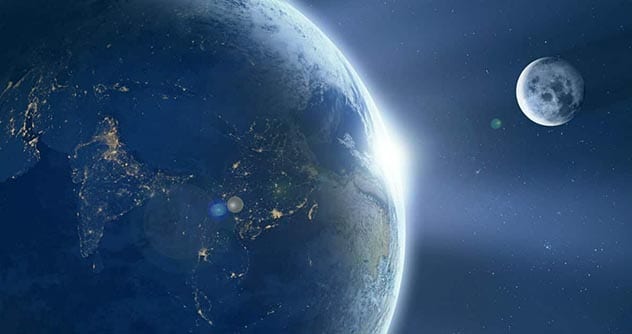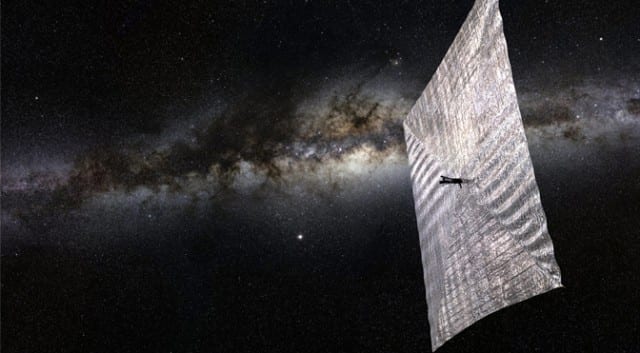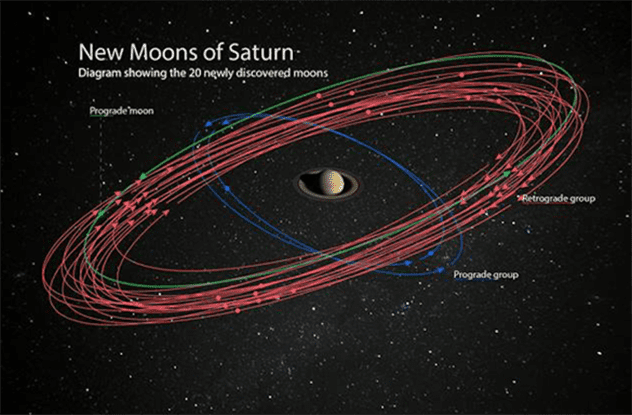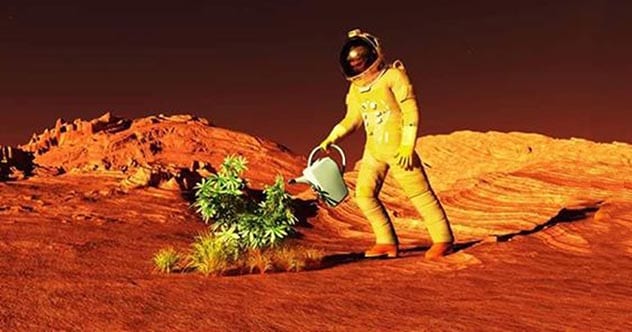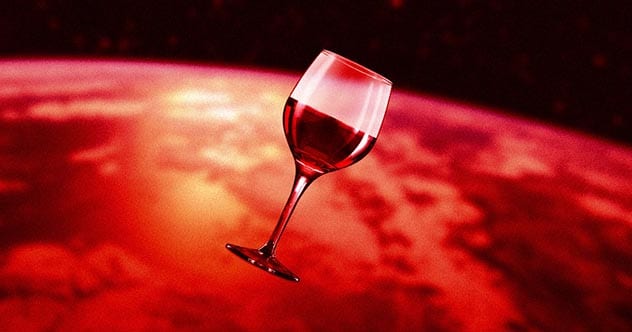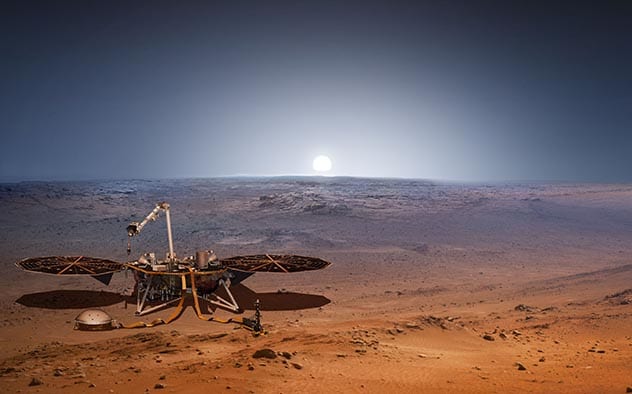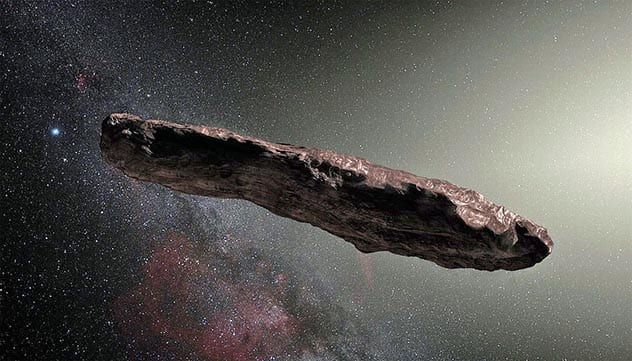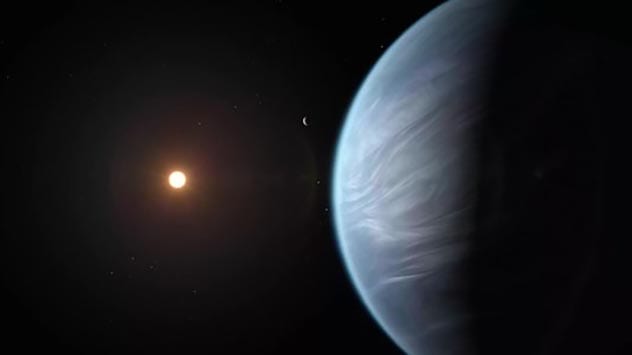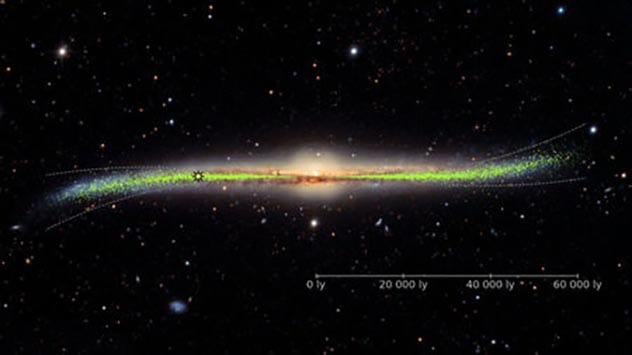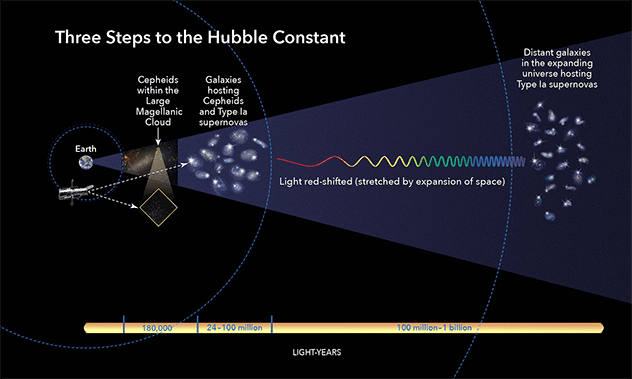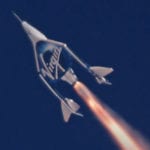See Also: 10 Space Myths We Believe Because Of Movies There surely are certain space news and achievements that have been on everyone’s lips this year. Such is the case of the first photo of a black hole, or NASA’s new program to go back to the Moon in a few years. But other equally important findings in this field have been announced in the previous months and it is time to give them a little more light. From interstellar visitors to red wine for living on Mars, keep reading this list to know what humankind has learned this year about the cosmos we live in.
10 The Moon Is Inside Our Atmosphere
How high are the confines of our planet? Many organizations around the world argue that this height corresponds to an imaginary boundary called the Kármán Line. Such artificial limit establishes that outer space begins at about 100 kilometers (62 miles) high. At the same time, many of us were probably taught that the uppermost layer of the atmosphere, the exosphere, extends up to about 10,000 kilometers (6,200 miles) away from the Earth’s surface. Does that seem like too much height? Well, hard-core science says otherwise. In February, scientists from the Russian Space Research Institute published a paper confirming the furthest distance to which the Earth’s atmosphere extends. To do this, the researchers analyzed data from the Solar and Heliospheric Observatory (SOHO), a spacecraft launched by ESA and NASA more than two decades ago. In the most technical definition, our atmosphere makes contact with outer space along an area full of hydrogen atoms called geocorona. Based on the data obtained by the SOHO spacecraft, scientists have now been able to determine that the Earth’s geocorona extends up to 630,000 kilometers (391,460 miles) away, about 50 times the diameter of Earth. In comparison, the Moon is about 384,000 kilometers (238,600 miles) away from Earth. So in literal terms, the Moon is located well within the Earth’s atmosphere. The researchers responsible for the discovery say that this can affect the performance of space telescopes when trying to accurately observe the chemical composition of other stars and galaxies. So the factor of having such a large atmosphere should be taken into account in the future.
9 Solar Sails Really Work
When light particles called photons hit the surface of an object in space, they slightly “push” the object and make it move in a certain direction. This fact allows a spacecraft equipped with a reflective structure called solar sail to move across space thanks to the thrust provided by photons emitted by the Sun. To get the idea, imagine a sailboat being propelled by the wind, but in outer space. In July, the Planetary Society announced that its solar-sail-propelled satellite, known as LightSail 2, successfully reached a stable orbit around Earth using only the power of the Sun. On July 23, nearly a month after being launched into space, the 5-kilogram (11-pound) satellite deployed its solar sail without problems and turned it towards the Sun. By July 31, the spacecraft had reached a point two kilometers (1.24 miles) higher in its orbit, something the organization said was only possible due to the thrust the satellite received from the Sun. Thus, LightSail 2 becomes the first solar sail spacecraft in orbit around Earth. It has also become the second spacecraft propelled by a solar sail, after Japan launched a similar technology in 2010. Since they can transport payloads through space virtually forever and without fuel, solar sails have the potential to be the interstellar propulsion technology of the future. For example, a research program called Breakthrough Starshot plans to launch a solar sail spacecraft equipped with cameras at a fraction of the speed of light. Its objective will be to reach the nearest star system in a few decades.
8 Saturn, King Of Moons
The record for the planet with more moons has been subject to constant revisions over time. Ten years ago, for example, Jupiter was the planet with the most moons. It had 63 confirmed moons, two more than those known around Saturn. In fact, Jupiter remained the planet with more natural satellites for more than two decades. But that changed in October of this year, with the discovery of a new large group of moons orbiting Saturn. American researchers used the powerful Subaru telescope in Hawaii to analyze bright spots observed near Saturn. These objects had already been detected between 2004 and 2007, but only now scientists could identify their orbits. In this way, the team has been able to confirm twenty new moons around Saturn, bringing the total number of natural satellites on that planet to 82. By comparison, Jupiter has 79 moons confirmed to date. Of the 20 moons, 17 are retrograde – that is, they move in the opposite direction to Saturn’s rotation. Each of these retrograde moons takes more than three years to complete an orbit around its parent world. All the moons found are about five kilometers (3 miles) in diameter, and probably originated after the fragmentation of a larger moon around Saturn in the past. The 20 satellites will receive names of giants of the Inuit, Nordic and Gallic mythologies. Now, researchers hope to understand Saturn’s formation better thanks to these moons. But they also hope to discover more moons. Once next-generation telescopes come into operation, the discovery of much smaller moons around these distant planets will be possible.
7 Crops Can Grow Well On Mars And The Moon
Do you remember that scene in “The Martian” where the protagonist astronaut plants a potato crop on Mars? Well, you saw true science right there. Or at least that is what a new study published in October tells us. Researchers at Wageningen University & Research (Netherlands) decided to test the productive capacity of soils on Mars and the Moon. Their objective was to know if the option of planting crops will be possible when bases are installed in these celestial bodies in the future. To perform the experiment, the researchers used Martian and Lunar soil simulants developed by NASA, with some organic material added. In these soils they planted ten different species of plants, from peas to tomatoes. About five months later, the team analyzed the crops and observed that, except for spinach, the other nine types of plants grew well in both soils. In fact, edible parts of the plants could be collected, while their newly-produced seeds proved to be viable – that is, they gave birth to new plants. Of course, any crop on the actual Martian surface will face other challenges such as extreme temperatures or the radiation received. How can these problems be solved? Another study published in July states that the answer is in a lightweight material called silica aerogel. Such material allows the access of light and increases the temperature underneath, but does not allow harmful radiation to pass. Therefore, a thin silica aerogel shield could be placed on ice-rich regions of Mars, so that the heat inside melts the water and plant life can normally survive there.
6 Wine Is The Key To Staying Healthy In Space
Scientists seem to have found a way to keep astronauts in good shape, and no, it is not exercising. Red wine is. Yes, the alcoholic drink that humankind has praised for millennia has properties that can protect a person’s health during long-duration space flights. Due to weightlessness, the human body can lose much of its muscle mass after just a few weeks in space. And in future missions to Mars, for example, we must remember it will take us nine months to reach the planet. So muscle loss in astronauts during an interplanetary mission is a sure thing. But researchers from Harvard University have found out that an antioxidant called resveratrol can prevent bone and muscle loss in humans. The chemical compound is found in grapes, red wine, and even chocolate. As an experiment, rats were suspended in the air with chains to simulate the low gravity of Mars. For two weeks under such conditions, the rats were given small daily amounts of resveratrol. By the end of the two weeks, the researchers analyzed the rats and discovered that their muscle mass was almost the same as in normal gravity conditions. In contrast, rats that had also been suspended but were not fed resveratrol suffered significant muscle atrophy. The team believes that the effectiveness of resveratrol to preserve health in weightlessness is due to its anti-inflammatory and anti-diabetic properties. The next step in the research will be to determine how much of the compound is needed to keep an astronaut in his most optimal fitness.
5 The First Marsquakes Detected
In addition to understanding the nature of earthquakes on our planet, scientists also know that other worlds have their own ground quakes. For example, thousands of tremors have been detected on the Moon for decades. But on Mars, things are pretty different. Billions of years ago, the interior of the Red Planet cooled and the geological activity in the outer layers decreased considerably. This, coupled with the lack of dynamic tectonic plates and a magnetic field, have made Mars a desolate and almost dead planet during the last billions of years. However, Mars does not seem to be completely dead. In November 2018, a NASA spacecraft called InSight landed successfully on Mars, with the purpose of analyzing the interior of the planet. On April 6 of this year, the robotic lander was able to detect the first quake on Mars coming from below the planet’s surface. This tremor was more powerful than other “marsquakes” the probe had detected in earlier weeks. According to the team in charge of the mission, these quakes represent the first major evidence that Mars is still geologically active. Moreover, in mid-December the researchers confirmed the discovery of the first active seismic zone on Mars, an area called Cerberus Fossae. Regarding InSight, NASA plans to continue detecting marsquakes with the lander and eventually, thanks to the data received, learn what the planet is made of.
4 The First Interstellar Comet
Two years ago, the scientific community came to know the first interstellar object observed in our Solar System, the asteroid ‘Oumuamua’. But this year, a second interstellar object has been discovered. And, surprise, it is not an asteroid but the first interstellar comet we know about. On August 30, an astronomer named Gennady Borisov discovered the comet with the equipment of an observatory in Crimea. Subsequently, NASA and the European Space Agency (ESA) focused their attention on the object. By studying its trajectory and speed, scientists finally understood that the comet, named 2I/Borisov, comes from another star system. Incredibly, the properties of this comet are very similar to those of the comets of our own Solar System. It was soon determined that 2I/Borisov is composed of an icy core surrounded by a cloud of dust and gas, confirming its cometary nature. We now know that the comet’s nucleus is around one kilometer (0.6 miles) in diameter. In the months of October and November, multiple agencies and observatories took detailed photographs of the comet during its passage through the inner Solar System. The closest approach of 2I/Borisov to Earth will occur on December 28, when it will be about 290 million kilometers (180 million miles) away from us. After that, the comet will remain visible for a few more months. Its final fate is either to disintegrate because of its approach to the Sun or to continue flying on its way out of the Solar System to never return.
3 Water Found In A Habitable-Zone Exoplanet
Water is an essential substance for the continuity of life as we know it. But in addition to containing water, a planet also has to be in the “habitable zone” of its star to support life. That means that it must orbit its sun at a distance that allows the existence of liquid water on its surface. And thanks to the efforts of multiple researchers, 2019 marks the year we first found water in an exoplanet located in the habitable zone. The planet in question is called K2-18b, and is located 110 light-years away from our world. By observing the planet while it passed in front of its star, a group of researchers from the University of Montreal (Canada) was able to analyze the atmosphere of K2-18b. In September, such team and another group of scientists from University College London (England) published independent papers about their observations of the exoplanet. In what is a first for a habitable-zone exoplanet, the teams concluded that K2-18b has water vapor in its atmosphere, even in the form of clouds. This does not mean that the planet is actually habitable, though. K2-18b is nine times more massive than Earth, and has been described as a kind of mini-Neptune with a thick hydrogen atmosphere. However, this discovery proves that small Earth-like exoplanets can already be analyzed in detail in our time, which brings us closer to the possibility of finding life outside our Solar System.
2 Our Galaxy Is Warped
Thanks to academic texts and science books, we have always had the notion that our galaxy, the Milky Way, is flat and disk-shaped like a frisbee. After all, scientists have discovered that many spiral galaxies (the same type as ours) in the universe are flat. But it is time for that notion to disappear. A research team from the University of Warsaw (Poland) decided to measure the distance between our Sun and more than 2,400 stars in our galaxy, young stars of varying brightness known as Cepheids. With this data, the team was able to create one of the most accurate 3D maps of the Milky Way to date. The results of the research were surprising. While the center of our galaxy is effectively flat, the regions starting approximately from our Sun’s orbit bend more and more as one approaches the outer edges. In this way, the Milky Way is warped with one side pointing up and the other sinking in the opposite direction. Simply put, our galaxy is bent in an S-shape. Some stars on the outermost edges are several thousand light-years above or below the plane of the galaxy. This is the first time that scientists have been able to use direct measurements of the distance between the Sun and other stars. But it was not a simple task; it took the scientists six years to complete such measurements. Regarding why the galaxy is warped, the researchers believe it may be due to a collision between the Milky Way and other smaller galaxies in the distant past.
1 The Universe Is Expanding Faster Than We Thought
We have known for a long time that the universe is expanding. Galaxies seem to be separating from each other at an expansion rate that scientists have tried to know for decades. Such rate is pretty important, since by knowing the speed at which the cosmos has expanded from the Big Bang to this day, it is possible to calculate the approximate age of the universe. The most commonly accepted expansion rate assigns the universe an age of approximately 13.8 billion years. But a new study made public last April strongly disagrees with that value. According to observations of stars in neighboring galaxies made by the Hubble telescope, a multi-institutional research team concluded that the universe is expanding nine percent faster than we thought so far. By this estimate, the universe is 12.5 billion years old. Other researchers have also thought that this discrepancy points to a shorter cosmic age. After all, a faster expansion rate would mean that it took the universe less time to become as it is today. A team of scientists spanning three continents announced in September that their new observations give the universe an age of a couple of billion years less than previously thought. But the truth is that the dilemma of a faster-expanding universe is not resolved by thinking it is younger. For example, it has been discovered that some of the oldest stars in the universe formed more than 13 billion years ago. By the aforementioned estimates, this would mean that the first stars are older than the universe itself, which is not possible. Instead, it is more likely that the universe began to expand faster at some point in the past, for reasons we still do not know.
